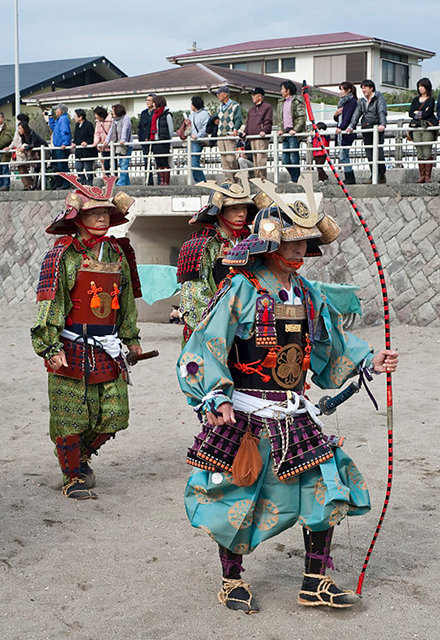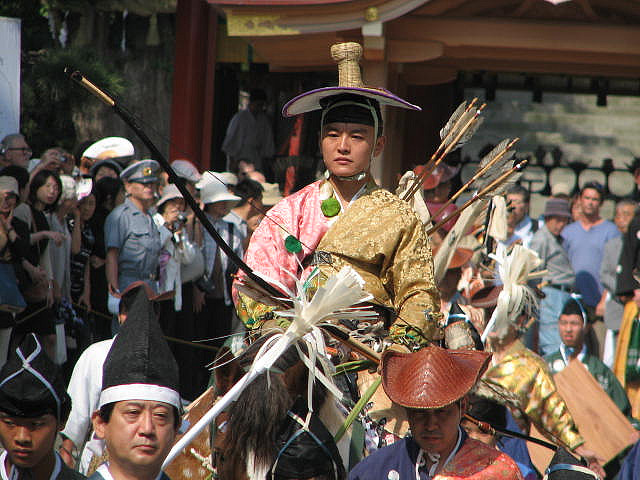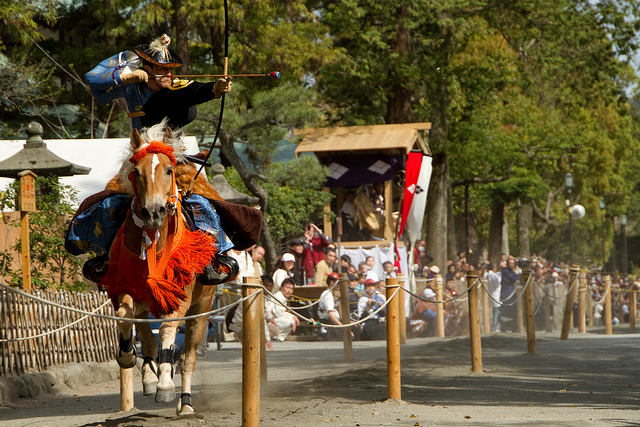What really sunk home for me is that we are recruiting for next year. Having our daughter Helene and her boyfriend Eric visit really helped us see that yes, we HAVE been here a year. We are comfortable with our world here, we are able to muddle along in Japanese to actually have a general sense of what is happening and we are able to share our world comfortably with guests.
Sunday 28 February 2016
On the work front...
What really sunk home for me is that we are recruiting for next year. Having our daughter Helene and her boyfriend Eric visit really helped us see that yes, we HAVE been here a year. We are comfortable with our world here, we are able to muddle along in Japanese to actually have a general sense of what is happening and we are able to share our world comfortably with guests.
Thursday 18 February 2016
Yabusame
Don’t let the simplicity of the sport (or ritual as most practitioners would prefer it to be called) lead you into thinking that it’s easy. The archers need to use both hands for shooting, so they have to rely on their knees alone to control the horses. As they let loose the arrows they shout ‘in-yo-in-yo’ – meaning darkness and light (the two opposite cosmic forces, sometimes called yin and yang). Hitting even one target is hard, and hitting all three is a major achievement – the mark of a supreme expert.
There was a period of around four hundred years, beginning in the fourteenth century, when yabusame was no longer practiced, but it was resurrected in 1728 on the orders of the then shogun, Yoshimune Tokugawa. At the time his son Ieshige was sick with smallpox, 
(These yabusame judges at Zushi are dressed in armour, and each is carrying a pair of samurai swords. Internet pic)so he decided to use
yabusame as a petition to the gods to seek a cure. As the rules of yabusame had been written down in the twelve century, it was possible to resurrect it and perform it again exactly as in ancient times. Happily, the gods obliged, and Ieshige made a complete recovery, eventually going on to succeed his father as shogun.
As with kyudo (ordinary Japanese archery without horses), yabusame is a solemn activity, and is about a lot more than just equestrian prowess and skill with a bow. It was originally intended to increase both the mental strength and religious devotion of the samurai who took part, as well as honing their battle skills. To this day, a yabusame archer is expected to follow the principles of bushido (the way of the warrior), and so must respect God and his ancestors, and act with good manners at all times. The Ogasawara School even teaches its pupils the correct way of bowing and of opening and closing doors.
Archers compete not for money, but for honour – the best performing archer is given a white cloth to signify divine favour, but receives no monetary payment. Even being selected as a yabusame archer is seen as a great honour – yabusame teachers are not paid, so their principle gain in passing on their skills is to increase their reputation by producing skilled pupils.
Yabusame can be seen either as an offering to, or entertainment for, the gods (although we mortals are usually allowed to watch as well). Both the arrows that hit their targets, and the targets themselves, are kept and treasured as good luck charms. The Ogasawara also use yabusame as a form of weather forecasting. The count of the number of arrows that hit the targets is used to predict how good the harvest will be in the years to come.
Yabusame archers are still equipped exactly as they were in the twelfth century. They wear medieval hunting outfits, including a distinctive woven-reed hat, a cloak, an arm guard, and a deerskin fur covers their legs. They carry a quiver of arrows on their back (from which they must draw new arrows as they gallop past the targets), a bow, a lacquered riding crop, and a pair of samurai swords – one long and one short.
If you couldn’t see the other spectators, there’d be nothing to indicate that you weren’t in twelfth-century Japan – everything else is exactly as it was then. Well, except that samurai who performed poorly were sometimes required to commit seppuku (ritual suicide by disembowelling) – that doesn’t go on any more. The best thing is that you can get really close up to the action – only a rope fence separates you from the galloping horses.
Wednesday 10 February 2016
Lovely to have more family visits!
Tuesday 2 February 2016
Skiing in Japan 2; we learn more...






Monday 1 February 2016
Technical details
The Sumo post seems to have had some issues with photos and videos. Because there are so many in that post it seems like it takes a while to download so try letting the post stand for awhile and hopefully photos and videos will download. Enjoy!








































